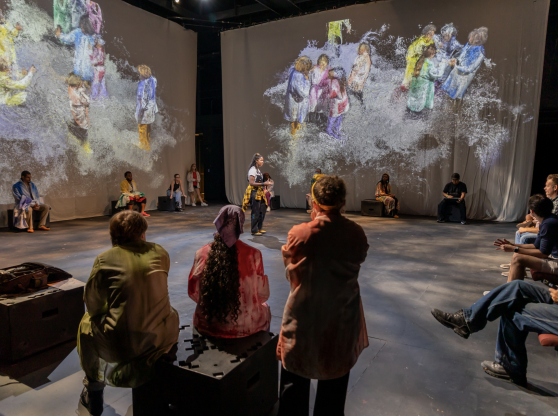What does a game-winning touchdown pass sound like?
If you’re a Gator, you might conjure up memories of The Swamp roaring or Mick Hubert delivering an iconic call over the airwaves. Isolate the playing field from the audience, and you might imagine sounds of cleats on grass, gloves touching the pigskin or players celebrating.
But what about the movement itself? How does the arcing motion of a thrown football translate to audio?
College of the Arts School of Music alumnus Benjamin O’Brien (Ph.D. Composition ‘15) has answers, and he is applying them to sports and music.
“When a quarterback throws a football, its position vector changes over time,” O’Brien said. “These position values can be used to calculate, for example, the football’s velocity or acceleration, which, in turn, can be mapped and scaled to parameters for sound synthesis… we could choose to scale the football position in proportion to frequency and—assuming our quarterback has a great arm—we would expect to hear a frequency glissando.”
O’Brien’s research satisfies intellectual curiosity, but it also has important real-world application. In September, he co-presented research at the International Symposium on Computer Music Multidisciplinary Research in Porto, Portugal, in which he turned the golf-putting motion into sound.
He then tested twenty subjects on whether the sounds he developed could help their golf swings. It worked.
“Using the audio programming language Max/MSP, I developed the sounds used in the experiment through different combinations of synthesizers, mapping functions and other synthesis parameters,” he said. “While the complete analysis will be available in a pending publication, I can say that certain synthesis parameters created more consistent swings across all subjects.”
This research was part of a larger project called SoniMove, which is financed by the National Research Agency (Agence nationale de la recherche). SoniMove develops Human Machine Interfaces that provide gestural control of sound in the areas of sports and music, according to O’Brien.
Q&A with Benjamin O’Brien
You’ve conducted more than ten research projects in your career according to your website. Of them, which was the most interesting to you?
My recent work has definitely been the most interesting and rewarding, because I get to synthesize my interests in sound, analysis and computer development for the purposes of studying sound and its effect on human behavior. That being said, it’s clear that my previous work in music composition and performance has had a profound affect on my approach to sound.
What has been your favorite thing about living in Marseille, France, and working at the Institute of Movement Science?
For being a major French city, Marseille is special because of its access to the Mediterranean Sea and mountains. You can hike a calanque, which is an arid, rocky cliff on the Mediterranean, for 45 minutes and then go swimming! Working at ISM is great, because I work with an international team of researchers from France, Poland and the U.S., who have expertise in the diverse fields of psychology, biomechanics and, of course, sound. Our work is highly collaborative, as we are developing studies and experiments that involve active and passive data acquisition systems, sound synthesis and analysis of kinematic data.
Who are some of your biggest influences as a composer, researcher and/or performer?
My teachers. I have been fortunate to study and work with some amazing musicians and thinkers. Studying with Dr. Paul Koonce at UF for my Ph.D. in composition was an invaluable period for me. Professor Koonce is curious and rigorous, both of which are without question necessary to be a great composer and researcher. His approach to software development, composition, and dedication to his students is unrivaled and inspirational.
In addition, Fred Frith and Roscoe Mitchell, who I studied with during my masters at Mills College, instilled in me the importance of listening. Improvisation is all about reading context, and, to be a good improviser—and I’m not just talking about music here—one can’t just hear, but listen. I am still digesting their performances and lessons. Their idiosyncratic approaches to music making continues to inspire my compositional work.
Did you always have an interest in music composition, or specifically electro-acoustic music, or was that something that developed later in your life and career?
A friend of my mine once asked me, “How many electroacoustic composers first started out as electric guitarists?” I think when you start playing around with the guitar and its pickups, pedals and amplifiers you are definitely entering the domain of electroacoustic music. So, I guess I’ve been interested in it for about two decades. Honestly, I think when I started using computers to analyse sound in order to better understand it in terms of its frequency spectrum or envelope, I started thinking about it more as a researcher.
What advice would you give someone interested in following a career path like yours?
First would to be and remain curious. However, don’t just try something haphazardly—really immerse yourself in a sound, style or software. Try to find the limits of these things. Really throw yourself into the deep end and find out if you can swim! I really can’t stress this point enough.
Second is to collaborate with people who have shared interests, but also specialists who might not appear to have anything in common. Part of this is to get you out of your comfort zone and give and take critique. You’ll also learn how difficult it can be to communicate an idea, especially when developing art, and how to develop a common language, which might inspire your own development.
When O’Brien was twelve years old and playing in his first rock band, he did not expect his guitar to lead him here.
In fact, as a University of Virginia undergraduate, he focused on mathematics and studied jazz improvisation on the side. It was not until his senior year that he began thinking about a career in music.
“I took an introduction to computer music course with Dr. Ted Coffey, a former student of Professor Koonce. This course was eye—or should I say ear—opening,” O’Brien said. “While it covered many topics and approaches to developing sound with computers, it made evident the strong connection I had between my math and musical coursework. I now had a path or outlet to apply my four years of studying transfer functions and logic for synthesizing sound and making music.”
He made up his mind when he attended a master class instructed by electric guitar virtuoso Kurt Rosenwinkle.
“Someone asked him about his approach to practice and he analogized about how he had a small plant in his stomach and that everyday he would water it, give it a little sunlight, a little dirt, et cetera,” O’Brien recalled. “He made the point that if he just dumped a lot of fertilizer or water, it would kill the plant.”
That philosophy resonated with him. He applied for a master’s degree in music composition at Mills College.
Studying at Mills and later at the University of Florida for his Ph.D. allowed him to build on and develop his newfound passion for synthesizing music and technology. His work led him to where he currently resides in Marseilles, France.
There, O’Brien works alongside a team of researchers from around the world who have expertise in a wide range of fields, including psychology, biomechanics and sound. He is a research engineer and helps develop techniques for sonifying movement. However, his work as a composer and performer on the side has been equally remarkable.
In 2016, Tigrelab commissioned him for sound work on a video mapping piece presented at Prague’s Signal Festival. The Barcelona-based studio gave him four words describing a fantastic creature: repetitive, sinuous, metallic and loop. He composed a short work with which they developed 3-D images that were then projected onto a building.
“Before I began composing the work, I decided on selecting a single but identifiable sound and developed it in ways that reflect the four words describing the creature,” O’Brien said. “I chose the sound of the piano and, to evoke the creature’s descriptors, used recordings of traditional and extended techniques and processed them in different ways.”
He also noted that as a sound design teacher at Les Ateliers de l’Image et du Son, he often uses this experience as an example.
“I ask my students how might they approach this project,” he said. “It is always interesting to hear how they might have approached the project.”
O’Brien will soon be embarking on a tour of Scotland with a group of experimental electric guitarists based in Berlin, Barcelona and Marseille. At these shows, he will be using digital signal process techniques he developed to reimagine what an electric guitar can sound like.
“My electric guitar plugs into my computer interface, which outputs the processed sound to a speaker or amplifier, and I can select and modify different effects with a foot pedal,” he said. “Working with this setup, I am interested in cultivating a performance practice that, at times, suggests a transformation of the electric guitar from a musical instrument into a (sound) controller.”
The group is still figuring out tour dates, but they plan to hold concerts and master classes in Glasgow, Edinburgh, Aberdeen and Dundee that showcase each of their unique approaches to the electric guitar.
“While I haven’t met the other guitarists, I know their approaches differ than my own and are more rooted in the experimental and jazz disciplines,” he said. “It should be a lot of fun. I look forward to learning from and collaborating with them.”
You can read more about Benjamin O’Brien at his website, http://benjamin-obrien.com/.



